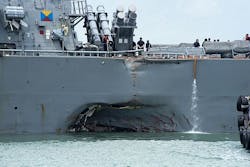Two Navy surface warship maritime collisions in two months; what's going on in the Pacific?
The U.S. Navy's Arleigh Burke-class guided missile destroyer is among the world's most modern warships. It's packed with sensors, advanced navigation equipment, and other technologies designed to keep the vessel safe even in the most difficult maritime conditions.
Nevertheless, in the course of only nine weeks two Burke-class destroyers operating in the Western Pacific have collided with big, lumbering cargo ships more than three times the size of the destroyers, leading to death and injury to U.S. military personnel.
On 17 June the destroyer USS Fitzgerald (DDG 62) collided with the Philippine-flagged container ship MV ACX Crystal off the east coast of Japan. Then just this week, on 21 Aug., the USS John S. McCain (DDG 56) collided with the oil and chemical tanker ALNIC MC in the Straits of Malacca near Singapore.
Both of those cargo vessels each displace about 30,000 tons of water, and are more than two football fields long. Typically they don't move all that quickly, and take a long time to turn. They're not quick and maneuverable.
Related: Navy to consider whether crashed warships were hacked
The Burke-class destroyer, on the other hand, displaces about 9,000 tons of water, is 509 feet long, and can move faster than 30 knots. It's extremely maneuverable; it can turn 180 degrees in about a minute.
The big question is why ... and why should there be two similar accidents involving similar vessels in the same region of the world so closely together?
The answer is unclear, at least for now. There's been a preliminary investigation of the June collision that involved the destroyer Fitzgerald, which claims the accident was the Fitzgerald's fault. That mishap killed seven and injured as many as 300, including the ship's captain Cmdr. Bryce Benson.
As a result, Benson, and two others among the ship's senior leadership were relieved of duty aboard the ship. Others relieved of duty aboard the Fitzgerald were Executive Officer Cmdr. Sean Babbitt, and Master Chief Petty Officer Brice Baldwin.
Suffice it to say that what happened aboard the Fitzgerald was really bad, with serious breakdowns in the chain of command, and deficiencies of seamanship. Those relieved of duty likely are looking at the ends of their naval careers.
Related: Massive October ballistic missile defense test used Mercury's OpenVPX embedded computing
All right, we know that mistakes can and do happen, but twice in two months? Speculation for the accidents has ranged from intentional ramming to cyber attacks on the destroyers' navigation systems. Neither has been proven.
We're not certain what happened aboard the destroyer McCain (named not for U.S. Sen. John McCain, R-Ariz., but for the senator's father and grandfather). It's too soon for any kind of investigation, and the latest news reports list 10 of the McCain's crew as missing, with at least one of them dead.
The McCain's collision with the ALNIC MC in the Straits of Malacca near Singapore on Monday happened in some of the most congested waters on Earth. Virtually all the world's commercial ship traffic passing between the South China Sea and the Indian Ocean go through there. Still, naval surface warfare officers in command aboard the McCain are well trained in operating through congested and dangerous waters. What happened was far from routine.
Maritime accidents like these have big consequences; it doesn't involve just a bunch of big dents and scrapes.
A modern large cargo vessel is designed with what's called a bulbous bow. This is a common design feature of many different vessels, large and small, commercial and military. It's a protruding bulb at the ship's bow just below the water's surface that reduces drag, and increases speed, range, fuel efficiency, and stability.
Related: Navy on the verge of major shipboard electronics breakthroughs
In a collision, however, the bulbous bow acts like the naval ram found aboard surface warships from before the age of sail, like the Greek and Roman war galley. The naval ram was an underwater reinforced beak fitted to the vessel's bow, designed to pierce the hulls of enemy vessels to sink them quickly. The naval ram was an effective weapon for about 2,000 years, and disappeared when surface warship propulsion changed from oars to sails.
The bulbous bows of the MV ACX Crystal and the ALNIC MC pierced the hulls of the destroyers Fitzgerald and McCain below the water line, causing massive flooding below decks on the destroyers. Deaths usually happened by drowning before the Fitzgerald's and McCain's crews could get the flooding under control.
It's a testament to the skill of damage-control crews aboard those two destroyers that the Fitzgerald and McCain remained afloat. Damage below the water line of these two destroyers was significant.
As a result of these two ocean collisions so close together, U.S. Chief of Naval Operations Adm. John Richardson on Monday ordered a pause in naval operations to review maritime practices in the Pacific.
We'll see what the operational pause reveals. Let's hope the Navy can make some changes to prevent these accidents from happening again.
Learn more: search the Aerospace & Defense Buyer's Guide for companies, new products, press releases, and videos
